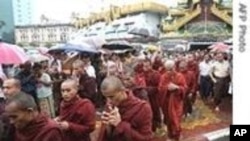At the end of September two years ago, Burma's military government
ordered troops to crush pro-democracy demonstrations led by Buddhist
monks. As the second anniversary of the demonstrations approaches,
security forces in Burma's largest city, Rangoon, are on high alert to
prevent a repeat of the Saffron Revolution, named after the robes worn
by the monks who led the movement. But as we learn in the following
report, some of which contains video smuggled to VOA from inside Burma,
the country's pro-democracy forces want to ensure that the Burmese
people, and their government, remember what happened two years ago.
Kaye Lin of VOA's Burmese Service narrates the story.
Security
is tight in the city of Rangoon and the streets are quiet, very
different from how they were two years ago, when tens of thousands of
people marched in the streets calling for an end to military rule. At
the forefront of the demonstrations were Buddhist monks, who chanted
prayers, or metta, for the success of the demonstrations.
"All peacefully get together and march. With metta meditation, we will help each other. I will also be there," said a monk.
The
demonstrations of 2007 reached their peak toward the end of September,
and people began to hope that Burma would find a peaceful way to
democracy.
But that hope ended the 26th of September, when the
military government ordered its troops to use whatever force was
necessary to end the demonstrations. The troops were joined by
baton-wielding members of Swan Ar Shin, a pro-government militia.
Scenes
of the brutality were shown around the world, including the death of a
Japanese journalist who was shot at close range. The government said
37 people were killed in the protests, but opposition leaders say the
figure is far higher. Some monks arrested in 2007 have yet to be
released.
This September, anxious to prevent a repeat of the
2007 demonstrations, the government has placed security forces around
potential trouble spots, including the Shwe Dagon Pagoda, one of the
many Buddhist temples that is being watched.
One monk, in an
interview smuggled to VOA, says the government has restricted the
movement of the monks, especially the younger ones. For his safety, we
have blurred his face.
"Monks are not able to go on their
trips as they wish. Their identity documents are checked and we are
questioned and interrogated very often. We're not free. The younger
monks have a difficult time," said a young monk.
Those monks who are given permission to travel report that government agents always follow them.
But
for all the government's efforts, Burma's pro-democracy movement has
survived. A group of monks who call themselves the "All Burma Monks
Alliance" has issued two demands to the government: It must apologize
for its treatment of the monks and it must release all the monks who
have been imprisoned since September 2007.
The alliance has set
a deadline of October 3 for the government to meet its demands. If
it does not, the alliance is urging all the monks in the country to
reject alms and donations from the authorities, which is a subtle form
of moral punishment in the Buddhist way. And the campaign has gained
support. As above, this monk's comments were smuggled to VOA.
"We
have to listen to and to live in discipline under our leaders and
senior abbots. In my soul, my heart is always with the monks who are
ready to protest for the people," he said.
In Rangoon,
supporters of democracy say the city is calm, but that it is an uneasy
calm. They also say the city will not live in fear or silence forever.
News
2 Years Later, Burmese Recall Their Saffron Revolution
update
- By Than Lwin Htun

<!-- IMAGE -->






